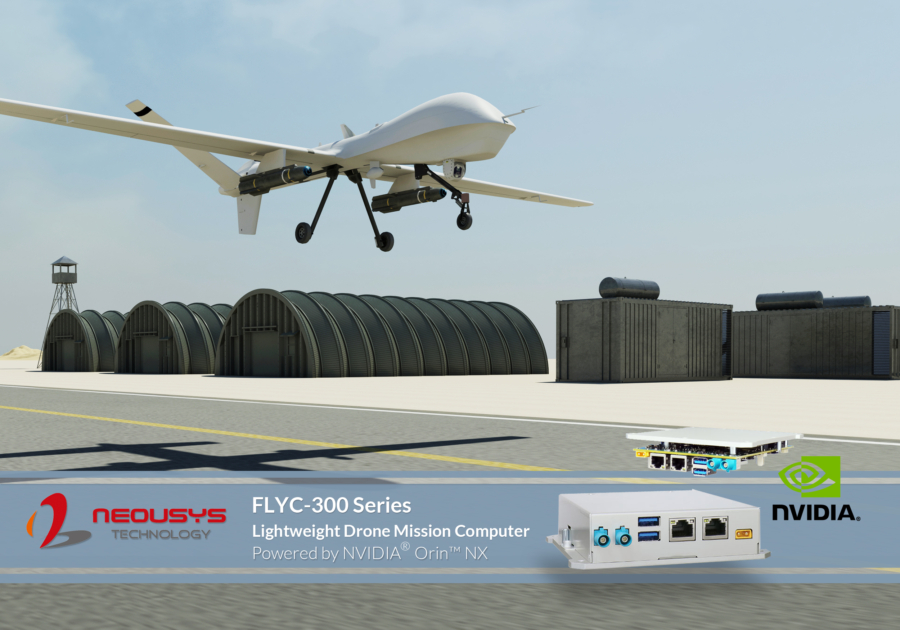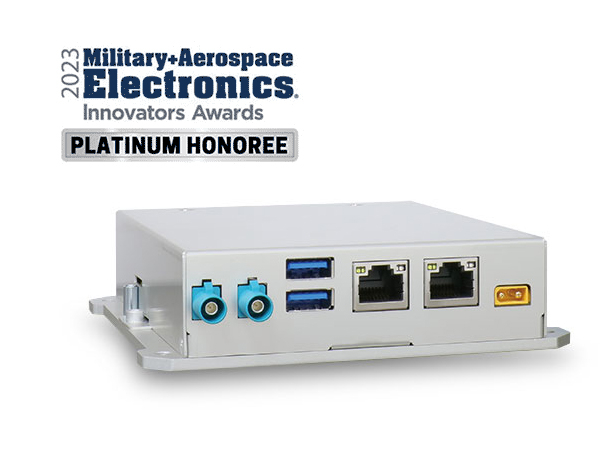In this article:
- Introduction
- Application Architecture
- Meeting the Challenges
- Neousys FLYC-300: Elevating UAV Capabilities:

Introduction
Unmanned Aerial Vehicles (UAVs) have indisputably transformed the landscape of modern warfare, offering unparalleled capabilities for information gathering and engagement with enemy forces. The ongoing evolution of UAVs brings forth increasingly intricate demands on their mission computers, driving the need for continuous advancements in computing, input/output (I/O) flexibility, and the meticulous calibration of size, weight, power, and performance (SWaP2C2). This article delves into the pivotal role of UAV mission computers, exploring their application architecture, functional requirements, and the challenges encountered in achieving the elusive balance of optimal SWaP2C2.
Application Architecture
The mission computer serves as the nexus of UAV operations, orchestrating the storage, control, and operation of the aircraft. UAV operators input detailed flight plans, meticulously managed by the mission computer. This dynamic orchestrator determines the UAV’s path and regulates the activation of the payload computer for sophisticated sensor data processing. The navigation function, integral to autonomous flight, is utilised for executing predefined patterns or orbits, either designed before flight or loaded from a ground station during line-of-sight operations. For optimal functionality, a UAV’s mission computer demands a delicate equilibrium of I/O flexibility, moderate processing performance, and SWaP2C2 considerations.
Functional Requirements:
- I/O and Processing: The UAV mission computer must exhibit a dexterous fusion of flexible I/O capabilities and precise processing power without compromising the SWaP2C2 framework. Specialised I/O, such as MIL-STD-1553 and ARINC 429, plays a pivotal role in integrating diverse UAV processes. Configurability to match the UAV platform’s demands, including battlefield programming, is essential. Crucially, the inclusion of removable storage and USB ports, within a ruggedised, standards-based design featuring low power and convection cooling, becomes imperative.
- Balanced SWaP2C2: The paramount objective is to extend UAV mission durations, wherein overall weight and power requirements directly influence mission orbits. Effective power management strategies are indispensable to curtail onboard power consumption. Meticulous mission computer specifications, carefully tailored to minimise impact on mission duration while maximising processing performance, underscore the need for cost-effectiveness and adherence to industry standards. These aspects collectively enhance the suitability of mission computing solutions for UAV applications.
Meeting the Challenges
The journey of developing mission computers to meet the dynamic requirements of UAVs is riddled with challenges. The intricate balance of SWaP2C2 mandates sophisticated power management strategies to curtail overall consumption. Innovations in cooling methods become pivotal to prevent the encumbrance of extra weight, potentially hindering mission orbits. The multifaceted challenge extends to meeting specialised I/O demands, necessitating a flexible and configurable design capable of seamlessly adapting to various UAV platforms and operational scenarios.
As UAVs continue to reshape the fabric of modern warfare, the role of mission computers emerges as increasingly pivotal. Striking the right balance between I/O flexibility, processing power, and SWaP2C2 is crucial to meet the evolving demands of UAV missions. The development of mission computers that effectively address these challenges promises to significantly enhance the effectiveness and efficiency of UAV operations, solidifying their position at the forefront of military capabilities in the years to come.
Neousys FLYC-300: Elevating UAV Capabilities:
Neousys Technology, has recently introduced its latest drone mission computer – the FLYC-300. This cutting-edge device is powered by the formidable NVIDIA Jetson Orin™ NX system-on-module, delivering an exceptional 100 TOPS AI performance. Weighing a mere 297g, it stands out as an ultra-lightweight drone mission computer, making it an optimal choice for applications requiring artificial intelligence and autonomy in drone operations.
The FLYC-300’s versatility is highlighted by its support for GbE/GMSL2/USB3 connectors, facilitating seamless integration of various sensors and cameras for comprehensive data acquisition across diverse applications. With an impressive AI inference power of 100 TOPS, the FLYC-300 excels in tasks such as object/facial recognition and obstacle avoidance.
Addressing the data acquisition needs of various applications, it is equipped with two Ethernet and USB3.2 ports, accommodating an array of high-resolution cameras, SWIR cameras, hyperspectral cameras, LiDAR, thermal cameras, 3D cameras, and more. By deploying the FLYC-300 on a drone, it empowers autonomous military UAVs for high-risk operations, including reconnaissance, target search, communication relays, maritime patrol, rescue support, and beyond.
Designed with Neousys’ proven rugged construction, it supports a wide voltage input range from 4S to 14S battery packs via the XT30 DC-IN connector. Seamless communication with the flight controller through configurable UART, Ethernet, and CAN ports streamlines the integration process, allowing developers to effortlessly incorporate the FLYC-300 into general drones. This ensures a robust solution for diverse drone applications.
The accolades received by the FLYC-300, including the Platinum Award in the Embedded Computing category at the 2023 MAE Innovators Awards, attest to its transformative impact. Neil Liu, Product Manager at Neousys Technology, underscores the significance, stating, “Neousys FLYC-300 can bring UAV systems to a whole new level, empowering them with vision and intelligence for enhanced operational effectiveness, risk reduction, and real-time information.”
In summary, the FLYC-300, with its ultralightweight design, robust connectivity options, and remarkable performance capabilities, is poised to elevate unmanned systems, ushering in a new era of intelligent autonomous UAVs with enhanced operational capabilities.

FLYC-300 Product Highlights
- Weighs only 297g for on-board installation
- Up to 100 TOPS GPU by Jetson Orin NX
- Supports multiple camera and sensor interfaces
- 2x GbE and 2x USB3 for RGB/ Infrared/ hyperspectral cameras and lidar/ radar
- 2x GMSL2 for HDR/ 3D cameras
- Built-in UART and CAN to interact with flight controller
- 1x M.2 2230 for storage and 4G/5G communication ready
- Supports 4S-14S drone battery pack
- EN62368-1, CE/FCC Class A, according to EN 55032 & EN 55035 and MIL-STD-810H certified.










